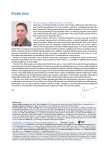-
Medical journals
- Career
Mechanism of implantation of the embryo
Authors: Renáta Krajčovičová; Igor Crha; Pavel Ventruba; Jana Žáková; Iva Vlašínová
Authors‘ workplace: Gynekologicko-porodnická klinika LF MU a FN Brno
Published in: Prakt Gyn 2012; 16(1): 20-26
Category: Assisted reproduction: Review article
Overview
The implantation of the embryo is complex and multistage process, which consists of complicated interactions between endometrium, myometrium, trophoblast and embryo. The result is implantation of the fertilized egg into the uterus. This mechanism is under the control of internal and external factors that are not exactly explained yet. Main steps are the adhesion of the embryo on the endometrium surface, the interaction between cells of endometrium and myometrium, overcoming mucins barriers, trophoblast invasion and its proliferations and decidualization. This work gives a comprehensive view of the possible causes of failure in the proces of the implantation, describes the diagnosis and treatment of these failures. We cannot reveal the cause of infertility in 10–20% couples, who undergo the diagnosis process. The mechanism of implantation are intensively investigated especially the unexplained infertility of the healthy couples, who don´t have any genetic, anatomical, hormonal or infectious problems and the transfer of the perfect embryo into well-preparated endometrium has repeated failure. Different recommended procedure improving implantation rate in IVF are described in the literature. Some of these methods are very simple (cleaning of the cervical canal before embryotransfer, using uterolytics drugs, the biopsy of the endometrium before ET) some are explicitly experimental (transcervical application of the seminal plasma or transcervical transfers of the genes responsible for the implantation).
Key words:
implantation of the embryo – nidation – implantation rate – infertility factors – embryotransfer – endometriosis – sactosalpinx – polycystic ovary syndrome
Sources
1. Nouza K, Madar J, Kučera E et al. Mechanismy ovlivňující implantaci embrya – novinky posledních let. Česká Gynekol 2006; 71(6):489–494.
2. Nouza K, Madar J, Nouza M et al. Imunologie a imunopatologie reprodukčního procesu. II. Imunologie těhotenství, opakovaného potrácení a poruch implantace blastocysty. Alergie 2007; 9(3): 233–240.
3. Achache H, Revell A: Endometrial receptivity markers, the journey to successful embryo implantation. Hum Rep Update 2006; 12(6): 731–746.
4. Daftary GS, Taylor HS. Pleiotropic effects of Hoxa10 on the functional development of peri-implantation endometrium. Mol Reprod Dev 2004; 67(1): 8–14.
5. Bagchi MK, Mantena SR, Kannan A et al. Control of uterine cell proliferation and differentiation by C/EBPbeta: functional implications for establishment of early pregnancy. Cell Cycle 2006; 5(9): 922–925.
6. Žáková J, Ventruba P, Vojtíšková M. Aktuální otázky vztahující se k preimplantační diagnostice. Asistovaná reprodukce 2000; 10(1): 18.
7. Cakmak H, Taylor HS. Implantation failure: molecular mechanisms and clinical treatment. Hum Rep Update 2011; 17(2): 242–253
8. Mára M, Holub Z et al. Děložní myomy – moderní diagnosti a léčba. Praha: Grada Publishing 2009. ISBN 978–80–247–1854–5
9. Hudeček R, Jelenek G, Felsinger M. Farmakoterapie endometriózy v reprodukční gynekologii. Prakt Gyn 2011; 15(2): 70–77.
10. Hudeček R, Felsinger M, Jelenek G. Dienogest v terapii genitálních forem endometriózy. Lékařské listy 2011 (3): 6–10.
11. Szekeres-Bartho J. Immunological relationship between the mother and the fetus. Int Rev Immunol 2002; 21(6): 471–495.
12. Hudeček R, Krajčovičová R: Embryoprotective therapy of infertil women with polycystic ovary syndome.In: Mukherjee S (ed) Open Access book project: Polycystic Ovary Syndrome. InTech 2012 : 61–76. ISBN 978–953–51–0094–2.
13. Kämmerer U, von Wolf, M, Markert UR. Immunology of human endometrium. Immunobiology 2004; 209(7): 569–574.
14. Kinský R, Chaouat G. Immunological factors predicting early pregnancy. In: Kurpisz M, Fernandez N (eds). Immunology of Human Reproduction. Oxford: Bios Scientific Publishers 1995; 217–233. ISBN 1–872748–59–7.
15. Moini A, Kiani K, Bahmanabadi A et al. Improvement in pregnancy rate by removal of cervical discharge prior to embryo transfer in ICSI cycles: a randomised clinical trial. Aus N Z J Obstet Gyneaco 2011; 51(4): 315–320.
16. Chou PY, Wu MH et al. Use of an oxytocin antagonist in in vitro fertilization-embryo transfer for women with repeated implantation failure: a retrospective study. Taiwan J Obstet Gynecol 2011; 50(2): 136–140.
17. Narvekar SA, Gupta N, Shetty N et al. Does local endometrial injury in the nontransfer cycle improve the IVF-ET outcome in the subsequent cycle in patients with previous unsuccessful IVF? A randomized controlled pilot study. J Hum Reprod Sci 2010; 3(1): 15–19.
18. Svobodová M, Brezinová J, Oborná I et al. Transferové médium s hyaluronanem EmbryoGlue v programu IVF+ET. Česká Gynekol 2007; 72(1): 15–19.
19. Stern C, Chamley L, Norris H et al. A randomized, double-blind, placebo-controlled trial of heparin and aspirin for women with in vitro fertilization implantation failure and antiphospholipid or antinuclear antibodies. Fertil Steril 2003; 80(2): 376–383.
20. Gutsche S, von Wolff M, Strowitzki T et al. Seminal plasma induces mRNA expression of IL-1beta, IL-6 and LIF in endometrial epithelial cells in vitro. Mol Hum Reprod 2003; 9(12): 785–791.
21. Daftary GS, Taylor HS. Reproductive tract gene transfer. Fertil Steril 2003; 80(3): 475–484.
Labels
Paediatric gynaecology Gynaecology and obstetrics Reproduction medicine
Article was published inPractical Gynecology

2012 Issue 1-
All articles in this issue
- Transfer-factor (IMUNOR) administration in women with chronic vulvovaginal discomfort: clinical study results
- The effect of hyaluronate in gynaecology and obstetrics
- Use of phytoestrogens in gynaecology
- Anaphylaxis in pregnancy
- Mechanism of implantation of the embryo
- Menstrual migraine (migraine without aura): diagnostic and possibility of hormonal treatment
- News in postcoital contraception
- Histopathological classification of breast cancer in relation to the use the types of systemic treatment
- Cancer stem cells in ovarian cancer
- Paravaginal hematoma: case report
- Practical Gynecology
- Journal archive
- Current issue
- Online only
- About the journal
Most read in this issue- Mechanism of implantation of the embryo
- Paravaginal hematoma: case report
- Transfer-factor (IMUNOR) administration in women with chronic vulvovaginal discomfort: clinical study results
- Menstrual migraine (migraine without aura): diagnostic and possibility of hormonal treatment
Login#ADS_BOTTOM_SCRIPTS#Forgotten passwordEnter the email address that you registered with. We will send you instructions on how to set a new password.
- Career

